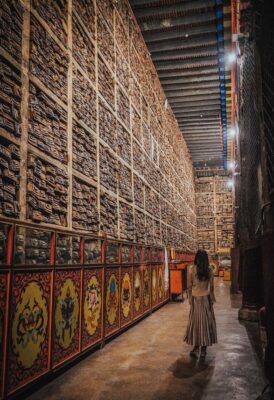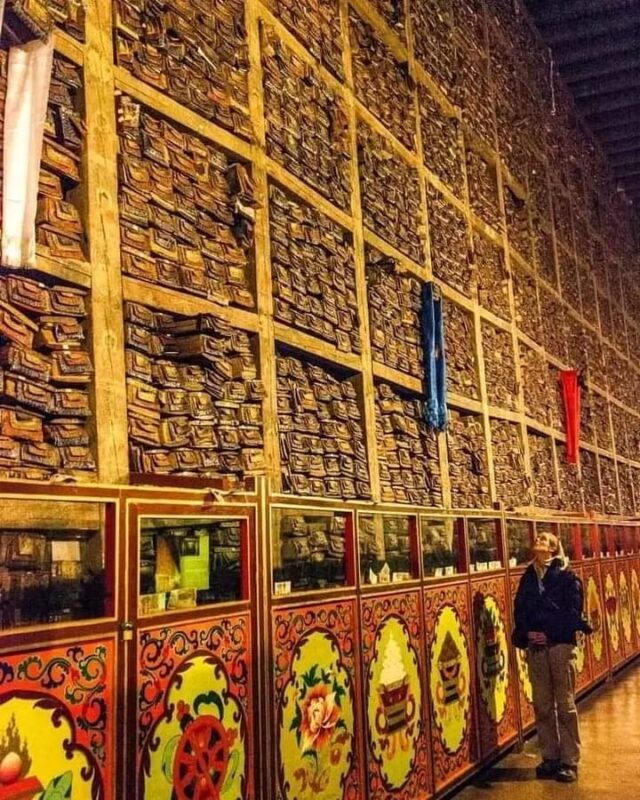The Sakya Monastery in Tibet is home to one of the most ancient and mysterious libraries in the world. Hidden behind a massive wall, archaeologists uncovered a treasure trove of 84,000 manuscripts, chronicling over 1,000 years of human history. Follow archeology.dulichvn.net to learn more about mysterious artifacts.

How Was the Enormous Library Discovered?
Hidden Within Sakya Monastery
Nestled in the remote highlands of Tibet, the Sakya Monastery stands as a beacon of spiritual and architectural splendor. Beyond its revered status as a Buddhist hub, the monastery concealed a secret that would astonish the world. Behind a colossal wall, measuring 60 meters in length and 10 meters in height, lay an extraordinary library—an archive of 84,000 manuscripts that remained untouched for centuries. The deliberate concealment of this treasure was likely a strategic effort to safeguard the priceless knowledge during times of upheaval. For generations, this hidden repository silently preserved the essence of humanity’s cultural and spiritual evolution.
A Breakthrough Discovery
The unveiling of the library was nothing short of a monumental achievement. Driven by curiosity and meticulous research, a team of archaeologists and historians embarked on an exploratory mission within the monastery. Subtle irregularities in the wall’s construction, combined with faint historical references to hidden knowledge, piqued their interest. Through careful excavation, the team uncovered the hidden chamber, revealing shelves lined with meticulously preserved manuscripts. Each document, crafted from delicate paper and adorned with intricate script, spoke of an era long past yet deeply influential to the present.
The discovery not only marked a turning point in the study of Tibetan history but also underscored the ingenuity and foresight of those who concealed these texts. It was a testament to the ancient custodians’ unwavering commitment to preserving knowledge, even in the face of adversity.
Historical Importance
The Sakya library is far more than a collection of ancient texts; it is a window into the soul of humanity. The manuscripts span over a millennium, chronicling pivotal moments in history, profound philosophical insights, and intricate cultural traditions. They include records of Buddhist teachings, spiritual practices, and governance systems, offering a comprehensive view of the intellectual and cultural pursuits of the time.
For Tibet, this collection represents an irreplaceable legacy, preserving the wisdom of its ancestors and the resilience of its culture. On a global scale, it provides a rare glimpse into the interconnectedness of human civilizations, revealing shared values and diverse interpretations of existence.
The library’s discovery not only enriches our understanding of the past but also inspires ongoing efforts to protect and cherish humanity’s collective heritage.

What Do the 84,000 Manuscripts Contain?
A Chronicle of Humanity’s Journey Over 1,000 Years
The manuscripts housed within the Sakya Monastery offer a breathtaking panorama of human history, spanning over a millennium. These ancient texts meticulously document significant events, social customs, and cultural traditions, creating a vivid tapestry of life across generations. From accounts of political shifts and dynastic changes to the intimate details of everyday life, the manuscripts serve as a timeless bridge connecting the past to the present. They provide scholars and historians with invaluable insights into the evolution of human societies, shedding light on how civilizations adapted, thrived, and occasionally faltered in the face of challenges.
Beyond their historical significance, these documents reveal the collective memory of humanity—one that captures the triumphs, struggles, and aspirations of our ancestors. Each page is a testament to the enduring spirit of discovery, adaptation, and innovation that defines the human experience.
Philosophy and Buddhism: A Spiritual Legacy
Embedded within this extraordinary collection are philosophical treatises and Buddhist scriptures that encapsulate the spiritual essence of Tibet and its surrounding regions. These texts explore profound questions about existence, morality, and the nature of the universe, offering guidance not only to the spiritual seekers of the past but also to modern readers searching for meaning and balance in life.
Among the manuscripts are intricate spiritual guides and commentaries, providing a roadmap for meditative practices and ethical living. They highlight the evolution of Buddhist thought, showcasing how this ancient religion adapted to the socio-political landscapes of different eras while remaining rooted in its core principles of compassion, wisdom, and enlightenment.
These philosophical works also illuminate the intellectual rigor of ancient scholars, whose interpretations and teachings continue to influence global spiritual discourse today.
The Artistic and Literary Soul of the Past
The Sakya library is not just a repository of history and religion; it is a treasure trove of creativity and artistic expression. Preserved within its walls are literary masterpieces, poetic compositions, and visually stunning illustrations that reflect the intellectual and cultural richness of ancient civilizations.
The poetry reveals a deep connection with nature, human emotions, and spiritual musings, often accompanied by exquisite calligraphy that itself is a work of art. Meanwhile, the artistic illustrations—crafted with remarkable detail and vibrant pigments—offer a glimpse into the aesthetic sensibilities and symbolic language of the era.
These artistic and literary works transcend time, reminding us of the boundless creativity and intellectual curiosity of our ancestors. They serve as a source of inspiration, demonstrating how art and literature have always been integral to human expression and understanding of the world.
In its entirety, this unparalleled collection encapsulates the depth and breadth of human ingenuity, spirituality, and resilience, making the Sakya library a priceless legacy for generations to come.

Value and Preservation Efforts
A Priceless Cultural Legacy
The library at Sakya Monastery stands as a monumental testament to the depth and richness of Tibetan culture. Within its 84,000 manuscripts lies a vibrant record of a civilization’s spiritual, philosophical, and artistic endeavors, offering a glimpse into the profound wisdom of the past. These texts not only preserve the identity and heritage of Tibet but also contribute to the broader tapestry of global human knowledge, connecting cultures and eras through shared narratives and timeless insights.
This treasure trove is more than a collection of ancient writings; it is a living legacy that bridges history and modernity, inviting exploration and understanding. As scholars delve into its contents, the manuscripts continue to inspire, educate, and enrich humanity’s appreciation for the intellectual achievements of our ancestors.
Preservation Amid Challenges
Safeguarding this invaluable heritage is no small feat, particularly given the harsh environmental conditions of Tibet. The high altitude, fluctuating temperatures, and low humidity pose significant risks to the delicate manuscripts, threatening to erode their physical integrity over time.
Human activities, including tourism and unregulated access, further exacerbate the challenges, underscoring the urgent need for effective preservation strategies. Recognizing this, a dedicated team of conservationists, historians, and preservation experts is working tirelessly to protect these ancient texts from both natural decay and human interference.
Efforts include climate-controlled storage, meticulous restoration of damaged manuscripts, and the implementation of strict access protocols to minimize handling and exposure.
Harnessing Modern Technology for Preservation
In an era of technological innovation, digitization has emerged as a powerful tool in the preservation and dissemination of cultural heritage. The manuscripts of Sakya Monastery are being carefully digitized, with high-resolution imaging capturing every detail of their content, including text, illustrations, and physical features.
This process not only creates a durable digital archive but also makes the manuscripts accessible to researchers, historians, and enthusiasts worldwide, breaking geographical barriers and ensuring their legacy endures. Advanced metadata tagging further enhances the usability of the digital library, enabling scholars to search and study the manuscripts with unprecedented ease.
By embracing technology, the custodians of this remarkable library are not only safeguarding its contents but also ensuring its stories and wisdom reach a global audience, inspiring new generations to value and preserve humanity’s shared cultural heritage.
In doing so, the Sakya Monastery library becomes more than a relic of the past—it transforms into a dynamic resource for the future, where history and innovation coexist in harmony.
See more: Explore The World’s Largest Mosaic Unearthed In Turkey
Conclusion
The discovery of the 84,000 manuscripts at Sakya Monastery is not just an archaeological breakthrough but also a symbol of the timeless wisdom and culture of humanity. This heritage must be cherished and preserved for future generations to explore and learn from.


CÁC TIN KHÁC
Mary Walton: The Forgotten Inventor Who Helped Clean Up America’s Cities
Tomb of Queen Nefertari in the Valley of the Queens, Egypt
Discover the Hypostyle Hall of the Temple of Hathor at Dendera
Venus de Losange: Unveiling the Mystery of a 20,000-Year-Old Paleolithic Icon